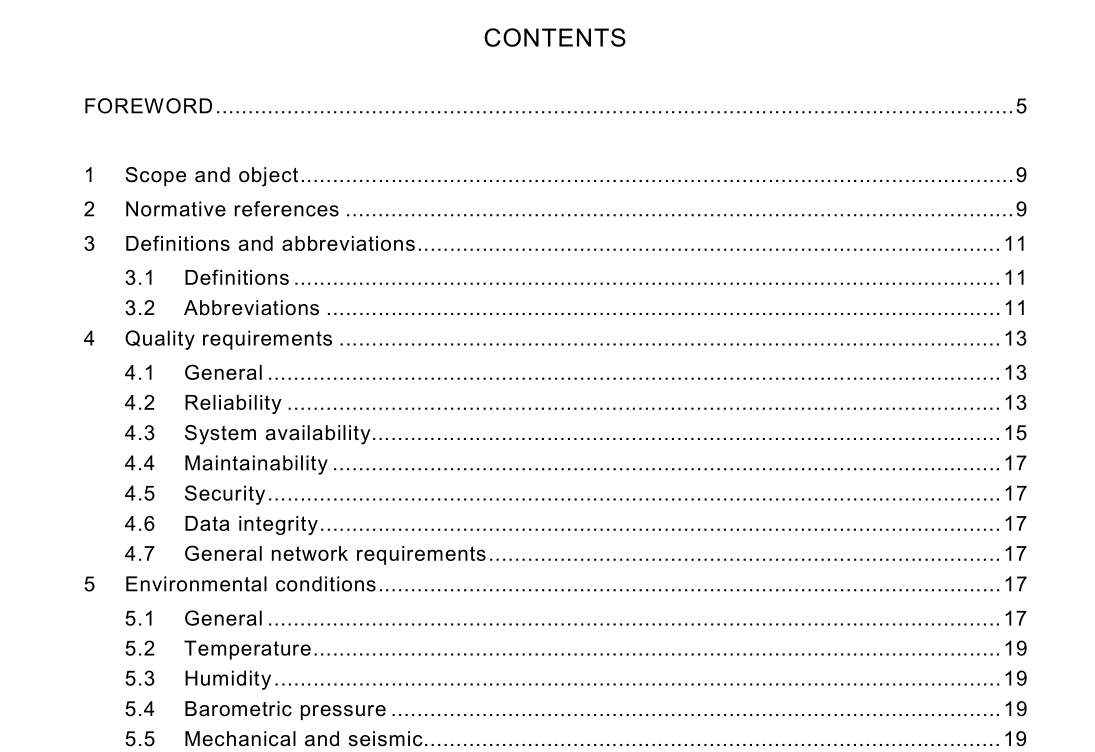IEC 61850-3 pdf download

IEC 61850-3 pdf download.Communication networks and systems in substations
1 Scope and object
This part of IEC 61850 applies to substation automation systems (SAS). It defines the communication between intelligent electronic devices (IEDs) in the substation and the related system requirements. The specifications of this part pertain to the general requirements of the communication network, with emphasis on the quality requirements. It also deals with guidelines for environ- mental conditions and auxiliary services, with recommendations on the relevance of specific requirements from other standards and specifications.
2 Normative references
The following normative documents contain provisions which, through reference in this text, constitute provisions of this part of IEC 61850. For dated references, subsequent amend- ments to, or revisions of, any of these publications do not apply. However, parties to agreements based on this part of IEC 61850 are encouraged to investigate the possibility of applying the most recent editions of the normative documents indicated below. For undated references, the latest edition of the normative document referred to applies. Members of IEC and ISO maintain registers of currently valid International Standards. IEC 60654-4:1987, Operating conditions for industrial-process measurement and control equipment – Part 4: Corrosive and erosive influences IEC 60694:1996, Common specifications for high-voltage switchgear and controlgear standards IEC 60870-2-1:1995, Telecontrol equipment and systems – Part 2: Operating conditions – Section 1: Power supply and electromagnetic compatibility IEC 60870-2-2:1996, Telecontrol equipment and systems – Part 2: Operating conditions – Section 2: Environmental conditions (climatic, mechanical and other non-electrical influences) IEC 60870-4:1990, Telecontrol equipment and systems – Part 4: Performance requirements IEC 61000-4-3:1995, Electromagnetic compatibility (EMC) – Part 4: Testing and measurement techniques – Section 3: Radiated, radio-frequency, electromagnetic field immunity test
IEC 61000-4-6:1996, Electromagnetic compatibility (EMC) – Part 4: Testing and measurement techniques – Section 6: Immunity to conducted disturbances, induced by radio-frequency fields IEC 61000-4-8:1993, Electromagnetic compatibility (EMC) – Part 4: Testing and measurement techniques – Section 8: Power frequency magnetic field immunity test IEC 61000-4-10:1993, Electromagnetic compatibility (EMC) – Part 4: Testing and measure- ment techniques – Section 10: Damped oscillatory magnetic field immunity test IEC 61000-4-12:1995, Electromagnetic compatibility (EMC) – Part 4: Testing and measure- ment techniques – Section 12: Oscillatory waves immunity test IEC 61000-4-16:1998, Electromagnetic compatibility (EMC) – Part 4-16: Testing and measure- ment techniques – Test for immunity to conducted, common mode disturbances in the frequency range 0 Hz to 150 kHz IEC TS 61000-6-5:2001, Electromagnetic compatibility (EMC) – Part 6-5: Generic standards – Immunity for power station and substation environments CISPR 22:1997, IEEE Standard for Information Technology Equipment – Radio Disturbance Characteristics – Limits and Methods of Measurement IEEE C37.90.2:1995, Withstand capability of relay systems to radiated electromagnetic interference from transceivers
4 Quality requirements
4.1 General This clause details the quality requirements such as reliability, availability, maintainability, security, data integrity and others that apply to the communication systems that are used for monitoring, configuration and control of processes within the substation. This clause contains a number of references to other IEC normative documents – with frequent reference to IEC 60870-4. IEC 60870-4 specifies performance requirements for a telecontrol system, classifying these requirements according to those properties that influence the performance of the system. These properties include such headings as reliability, availability, maintainability, security and integrity. For each of these properties, IEC 60870-4 lists a number of classes for these requirements, for which the systems resident in the substation can be expected to have to meet virtually the complete range. Where applicable, the conformance to a particular level of these classes shall be stated by the manufacturer, as defined in IEC 60870-4. 4.2 Reliability 4.2.1 General The substation shall continue to be operable, according to the “graceful degradation” principle, if any SAS communications component fails. There should be no single point of failure that will cause the substation to be inoperable. Adequate local monitoring and control shall be maintained. A failure of any component should not result in an undetected loss of functions nor multiple and cascading component failures.









